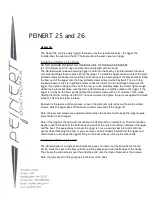
46
Section 10 - Anchoring Information
320 Outrage-Owner’s Manual
Anchoring Information
The 320 Outrage is equipped with an
anchor storage compartment located in
the bow of the boat. Wind and sea con-
ditions can affect the boat. The boat is
not moving through the water, and
without headway there is no control.
Note: before using the anchor be sure the anchor
line’s bitter end is secured to the eye in the bot-
tom of the anchor locker.
STAY ALERT!
Be sure that the anchor will hold under
all circumstances if you are leaving the boat.
Understand the principles of rode and scope and their
effect on anchor performance.
The rode is the line connecting the anchor to the boat.
Nylon line is ideal because it is light, strong and
stretches, it also can be stored wet and is easy to
handle. Add a length of chain between the anchor
and the nylon line to prevent abrasion of the line.
The scope is technically defined as the ratio of rode
length to the vertical distance from the bow to the
sea floor. Scope also depends on the type of anchor,
tides, winds, sea conditions and type of sea floor the
anchor is in.
Minimum is 5:1 for calm conditions
Normal is 7:1
Severe conditions may require a 10:1.
Since you want to know how much rode to use when
anchoring, use this common formula:
Rode length=(bow water depth) x
Scope
*Scope factor may range from 5 to 10 or more.
Any number less than 5 and the anchor breaks
away too easily.
Be sure to read the owner’s manual supplied by the
anchor windlass manufacturer before using the an-
chor windlass. Follow all recommendations and in-
structions regarding its proper use and care.
ANCHOR
Lowering the Anchor
Be sure that there is enough rope for the depth of
water you will be anchoring in, and secure rode to
both the anchor and the boat.
• Stop completely before lowering the anchor.
• Keep feet clear of coiled line as it pays out.
• Turn the anchor light on at night or during re-
duced visibility.
Setting the Anchor
There is no best way to set an anchor. Experiment to
see how it performs. One method is to turn the rode
around a bitt or a cleat and slowly pay out as the boat
backs from the anchor site. When the proper scope
has been reached snub the rode quickly, causing the
anchor to dig in to the sea bottom.
• Reverse the engine slowly to drive the anchor
in and to prevent it from dragging.
• Secure the rode to the bitt or cleat.
Weighing the Anchor
To weigh (or retrieve) the anchor, start the boat and
run slowly up to the anchor, taking up the rode as
you go. The anchor will usually break out when the
rode becomes vertical. Coil lines to let them dry be-
fore stowing.
BE CAREFUL THAT THE TRAILING LINES DO NOT
FOUL IN THE PROPELLER.
SWAMPING HAZARD-Anchor from the bow if using
one anchor. A small current can make a stern anchored
boat unsteady; a heavy current can drag a stern an-
chored boat underwater.
WARNING
There are a variety of anchors with a variety of uses.
Discuss the types with your dealer to find the right type
for your boat.
NOTICE
!
!
1
Anchor Locker
2
Bow Eye
3
Anchor Locker Bow Eye
4
Anchor Roller & Davit
5
25 lb.(11.35Kg) Anchor, (Standard Plow Type,-
Optional Stainless Steel)
6
Anchor Windlass
7
Emergency Anchor Release/Pull Handle
1
2
3
4
5
7
6






































